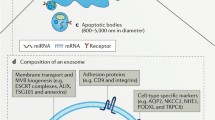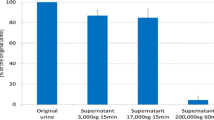Abstract
The permeability barrier of the urothelium (covering the mammalian urinary tract) has stimulated interest in the role of the luminal membrane in the barrier function. To know how membrane lipids may affect the permeability barrier we prepare endocytic vesicles of different lipid composition entrapping a fluorescent dye (HPTS) and its quencher (DPX) using a dietary strategy (rats fed with commercial, oleic acid- or linoleic acid-enriched diets) followed by endocytosis induction. Vesicular leakage was measured by a fluorescence requenching technique. The results showed (1) endocytosed vesicles can release their content; (2) a linoleic acid-rich diet did not change either the mechanism of leakage or the amount of released material relative to the control; and (3) a oleic acid-rich diet greatly affected the mechanism of release. Thus, the dietary fatty acids can modify the urothelial cell physiology altering the pathway of endocytosed urinary fluid.





Similar content being viewed by others
References
Kachar B, Liang F, Lins U, Ding M, Wu X-R, Stoffer D, Aebi U, Sun TT (1999) Three-dimensional analysis of the 16 nm urothelial plaque particle: luminal surface exposure, preferential head-to head interaction, and hinge formation. J Mol Biol 285:595–608. doi:10.1006/jmbi.1998.2304
Hainau B (1979) Luminal plasma membrane organization in rat urinary bladder urothelium after direct exposure in vivo to N-methyl-N-Nitosourea. Cancer Res 39:3757–3762
Hu P, Deng FM, Lian FX, Hu CM, Auerbach A, Shapiro E, Wu XR, Kachlar B, Sun TT (2000) Ablation of uroplakin III gene result in small urothelial plaques urothelial leakage and vesicoureteral reflux. J Cell Biol 151:961–971. doi:10.1083/jcb.151.5.961
Truschel ST, Wang E, Ruiz WG, Leung SM, Rojas R, Lavelle J, Zeide M, Stoffer D, Apodaca G (2002) Stretch-regulated exocytosis/endocytosis in bladder umbrella cells. Mol Biol Cell 13:830–846. doi:10.1091/mbc.01-09-0435
Clemow D, Steers W, Tuttle J (2000) Stretch-regulated signalling of nerve growth factor secretion in bladder and vascular smooth muscle cells from hypertensive, and hyperactive rats. J Cell Physiol 183:289–300. doi:10.1002/(SICI)1097-4652(200006)183:3<289::AID-JCP1>3.0.CO;2-6
Lewis S, de Moura J (1984) Apical membrane area of rabbit urinary bladder increases by fusion of intracellular vesicle: an electrophysiological studies. J Membr Biol 82:123–136. doi:10.1007/BF01868937
Wasungu L, Stuart MCA, Scarzello M, Engberts JBFN, Hoekstra D (2006) Lipoplexes formed from sugar-based Gemini surfactants undergo a lamellar-to-micellar phase transition at acidic pH. Evidence for a non-inverted membrane-destabilizing hexagonal phase of lipoplexes. Biochim Biophys Acta 1758:1677–1684. doi:10.1016/j.bbamem.2006.06.019
Calderón RO, Glocker M, Eynard AR (1998) Lipid and fatty acid composition of different fractions from rats urinary transitional epithelium. Lipids 33:1017–1022. doi:10.1007/s11745-998-0300-0
Calderón RO, Eynard AR (2000) Fatty acids specifically related to the anisotropic properties of plasma membranes from rat urothelium. Biochim Biophys Acta 1483:174–184
Bongiovanni GA, Eynard AR, Calderón RO (2005) Altered lipid profile and changes in uroplakin properties of rat urothelial plasma membrane with diets of different lipid composition. Mol Cell Biochem 271:69–75. doi:10.1007/s11010-005-4505-y
Calderón RO, Grasso EJ (2006) Symmetric array of the urothelium surface controlled by the lipid lattice composition. Biochem Biophys Res Commun 339:642–646. doi:10.1016/j.bbrc.2005.11.061
Cremonezzi DC, Diaz MP, Valentich MA, Eynard AR (2004) Neoplastic and preneoplastic lesions induced by melamine in rat urothelium are modulated by dietary polyunsaturated fatty acids. Food Chem Toxicol 42:1999–2007. doi:10.1016/j.fct.2004.06.020
Eynard AR, Manzur T, Moyano A, Quiroga P, Muñoz SE, Silva RA (1997) Dietary deficiency or enrichment of essential fatty acids modulate tumorigenesis in the whole body of cobalt-60 irradiated mice. Prostaglandins Leukot Essent Fatty Acids 56:239–244. doi:10.1016/S0952-3278(97)90542-1
Ladokhin AS, Wimley WC, Withe SH (1995) Leakage of membrane vesicle contents: determination of mechanism using fluorescence requenching. Biophys J 69:1964–1971. doi:10.1016/S0006-3495(95)80066-4
Ladokhin AS, Selsted ME, White SH (1997) Bilayer interactions of indolicidin, a small antimicrobial peptide rich in tryptophane, proline, and basic amino acids. Biophys J 72:794–805. doi:10.1016/S0006-3495(97)78713-7
Chang A, Hammond TG, Sun ST, Zeidel ML (1994) Permeability properties of the mammalian bladder apical membrane. Am J Physiol Cell Physiol 36:C1483–C1492
Wimley WC, Selsted ME, White SH (1994) Interactions between human defensins and lipid bilayers: evidence for formation of multimeric pores. Protein Sci 3:1362–1373. doi:10.1002/pro.5560030902
Lakowicz JR (1983) Quenching of fluorescence. In: Lakowicz JR (ed) Principles of fluorescence spectroscopy, 1st edn. Plenum Press, New York, pp 258–297
Lewis SA (2000) Everything you wanted to know about the bladder epithelium but were afraid to ask. Am J Physiol Renal Physiol 278:F867–F874
Wu XR, Medina JJ, Sun TT (1995) Selective interactions of UPIa and UPIb, two members of the transmembrane 4 superfamily, with distinct single transmembrane-domained proteins in differentiated urothelial cells. J Biol Chem 270:29752–29759. doi:10.1074/jbc.270.50.29752
Min G, Schapira M, Sun TT, Kong XP (2003) Structural bass of urothelial permeability barrier function as revealed by Cryo-EM studies of the 16 nm uroplakin particle. J Cell Sci 116:4087–4094. doi:10.1242/jcs.00811
Acknowledgments
This work was supported by grants from SECYT-UNC and CONICET, Argentina. We are grateful to María Laura Nores for her helpful criticism during the realization of this work.
Author information
Authors and Affiliations
Corresponding author
Rights and permissions
About this article
Cite this article
Grasso, E.J., Calderón, R.O. Urinary bladder membrane permeability differentially induced by membrane lipid composition. Mol Cell Biochem 330, 163–169 (2009). https://doi.org/10.1007/s11010-009-0129-y
Received:
Accepted:
Published:
Issue Date:
DOI: https://doi.org/10.1007/s11010-009-0129-y




